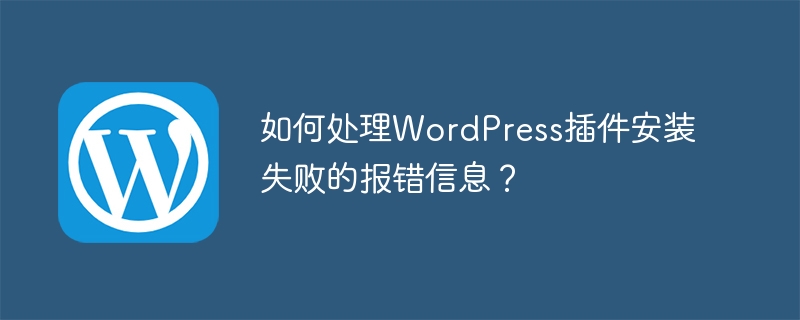Home >CMS Tutorial >WordPress >How to deal with error messages when WordPress plug-in installation fails?
How to deal with error messages when WordPress plug-in installation fails?
- WBOYWBOYWBOYWBOYWBOYWBOYWBOYWBOYWBOYWBOYWBOYWBOYWBOriginal
- 2024-03-04 16:57:031405browse

How to deal with error messages when WordPress plug-in installation fails?
As one of the most popular content management systems currently, WordPress has a rich plug-in library, providing users with various functional extensions and customization options. However, when using WordPress, sometimes plug-in installation fails, and error messages may appear, making users feel confused and anxious. This article will introduce some common WordPress plug-in installation failure error messages and how to deal with these problems.
1. Error message: The plug-in package cannot be decompressed
When you try to install a plug-in, sometimes you will encounter an error message such as "Cannot decompress the plug-in package." This is usually caused by WordPress being unable to unzip the plugin files to the specified directory. The solution to this problem is to manually upload the plugin files to the WordPress plugin directory. The specific steps are as follows:
1. Download the zip file of the plug-in to your local computer;
2. Log in to the WordPress backend and enter the plug-in management page;
3. Click the "Add New Plug-in" button;
4. Click the "Upload Plug-in" button at the top of the plug-in management page;
5. Select the downloaded plug-in zip file and click the "Install Now" button;
6. After the installation is complete, click "Activate Plug-in" to activate That’s it.
Code example:
<?php // 代码示例暂无,因为这里提供的是处理插件安装失败问题的方法,而非具体代码示例。 ?>
2. Error message: Unable to create directory
Another common error message for plug-in installation failure is "Unable to create directory". This is usually caused by WordPress not having sufficient permissions to create the folder in the specified directory. The solution to this problem is to modify the folder permissions or create the directory manually. The specific steps are as follows:
1. Log in to the WordPress root directory through FTP or file manager;
2. Find the wp-content/plugins directory;
3. Make sure the directory permissions are 755 or 777;
4. If the permissions are insufficient, you can modify the directory permissions through the FTP client;
5. Manually create the plug-in directory, and then upload the plug-in files to the directory.
Code example:
<?php // 代码示例暂无,因为这里提供的是处理插件安装失败问题的方法,而非具体代码示例。 ?>
3. Error message: Missing dependent plug-in
Sometimes installing a plug-in will prompt an error message that the dependent plug-in is missing. This means that installed plugins need to rely on other plugins to function properly. The way to solve this problem is to install the dependent plug-in first, and then install the target plug-in. The specific steps are as follows:
1. Check the dependent plug-ins mentioned in the error message;
2. Search and install the dependent plug-ins in the WordPress plug-in library;
3. Activate the dependent plug-ins;
4. Try installing the target plug-in again.
Code example:
<?php // 代码示例暂无,因为这里提供的是处理插件安装失败问题的方法,而非具体代码示例。 ?>
Through the above method, we can handle the error message when the WordPress plug-in installation fails. When you encounter a problem, don't panic, follow the steps in an orderly manner, and I believe the problem will be solved. I hope this article was helpful to you and I wish you good luck with your WordPress plugin installation process!
The above is the detailed content of How to deal with error messages when WordPress plug-in installation fails?. For more information, please follow other related articles on the PHP Chinese website!

